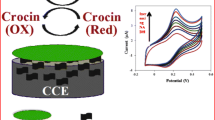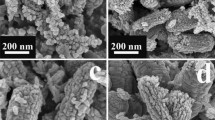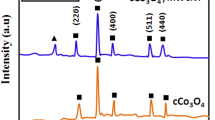Abstract
A corn-like CeO2/C coaxial cable textured by a cerium oxide shell and a carbon core was designed to sense NO. The carbon core possesses high electrical conductivity, and the CeO2 surface delivers excellent electrocatalytic activity. The sensor, typically operated at 0.8 V (vs. Ag/AgCl), exhibits a detection limit of 1.7 nM, which is 4-times lower than that of CeO2 nanotubes based one (at S/N = 3). It also displays wide linear response (up to 83 μM), a sensitivity of 0.81 μA μM−1 cm−2, and fast response (2 s). These values are highly competitive to that of a CeO2 tube (0.92 μA μM−1 cm−2 and 2 s). The sensor was used to quantify NO that is released by Aspergillus flavus.

Schematic representation of corn-like CeO2/C which can more sensitively and effectively detect NO released from A. flavus than when using CeO2 nanotubes, benefitting from its unique coaxial cable structure.






Similar content being viewed by others
References
Xu X-Y, Lian X, Hao J-N, Zhang C, Yan B (2017) A double-stimuli-responsive fluorescent Center for Monitoring of food spoilage based on dye covalently modified EuMOFs: from sensory hydrogels to logic devices. Adv Mater 29(37):1702298
Ma X, Mau M, Sharbel TF (2018) Genome editing for global food security. Trends Biotechnol 36(2):123–127
Godfray HCJ, Beddington JR, Crute IR, Haddad L, Lawrence D, Muir JF, Pretty J, Robinson S, Thomas SM, Toulmin C (2010) Food security: the challenge of feeding 9 billion people. Science 327(5967):812–818
Kumar D, Kalita P (2017) Reducing postharvest losses during storage of grain crops to strengthen food security in developing countries. Foods 6(1):8
Alum EA, Urom S, Ben CMA (2016) Microbiological contamination of food: the mechanisms, impacts and prevention. Int J Sci Technol Res 5(3):65–78
Rawat S (2015) Food spoilage: microorganisms and their prevention. Asian J Plant Sci Res 5(4):47–56
Ma Z, Chen P, Cheng W, Yan K, Pan L, Shi Y, Yu G (2018) Highly sensitive, printable nanostructured conductive polymer wireless sensor for food spoilage detection. Nano Lett 18(7):4570–4575
Jaime-Garcia R, Cotty PJ (2018) Crop rotation and soil temperature influence the community structure of Aspergillus flavus in soil. Soil Biol Biochem 42(10):1842–1847
Hedayati MT, Pasqualotto AC, Warn PA, Bowyer P, Denning DW (2007) Aspergillus flavus: human pathogen, allergen and mycotoxin producer. Microbiol 153(6):1677–1692
Castello PR, Woo DK, Ball KA, Wojcik J, Liu L, Poyton RO (2008) Oxygen-regulated isoforms of cytochrome c oxidase have differential effects on its nitric oxide production and on hypoxic signaling. Proc Natl Acad Sci U S A 105:8203–8208
Zhao J, Wang L, Xu D, Lu ZS (2017) Involvement of ROS in nanosilver-caused suppression of aflatoxin production from aspergillus flavus. RSC Adv 7(37):23021–23026
Govindhan M, Chen A (2016) Enhanced electrochemical sensing of nitric oxide using a nanocomposite consisting of platinum-tungsten nanoparticles, reduced graphene oxide and an ionic liquid. Microchim Acta 183(11):2879–2887
Guo CX, Ng SR, Khoo SY, Zheng X, Chen P, Li CM (2012) RGD-peptide functionalized graphene biomimetic live-cell sensor for real-time detection of nitric oxide molecules. ACS Nano 6(8):6944–6951
Yang T, Zelikin AN, Chandrawati R (2018) Progress and promise of nitric oxide-releasing platforms. Adv Sci 5(6)
Davies MJ (2016) Detection and characterisation of radicals using electron paramagnetic resonance (EPR) spin trapping and related methods. Methods 109:21–30
Yao HW, Zhu XY, Guo XF, Wang H (2016) An amphiphilic fluorescent probe designed for extracellular visualization of nitric oxide released from living cells. Anal Chem 88(18):9014–9021
Murphy ME, Noack E (1994) Nitric oxide assay using hemoglobin method. Academic Press 233:240–250
Kim S, Jung H, Lee C, Kim M, Lee Y (2014) Biological application of RuO2 nanorods grown on a single carbon fiber for the real-time direct nitric oxide sensing. Sensors Actuators B Chem 191:298–304
Liu H, Weng L, Yang C (2017) A review on nanomaterial-based electrochemical sensors for H2O2, H2S and NO inside cells or released by cells. Microchim Acta 184(5):1267–1283
Wang M-Q, Ye C, Bao S-J, Xu M-W, Zhang Y, Wang L, Ma X-Q, Guo J, Li C-M (2017) Nanostructured cobalt phosphates as excellent biomimetic enzymes to sensitively detect superoxide anions released from living cells. Biosens Bioelectron 87:998–1004
He Y-H, Xiang Y, Yang D-C, Guan Z (2016) Combining enzyme and photoredox catalysis for aminoalkylation of indoles via a relay catalysis strategy in one pot. Green Chem 18(19):5325–5330
Wu J, Wang X, Wang Q, Lou Z, Li S, Zhu Y, Li Q, Wei H (2019) Nanomaterials with enzyme-like characteristics (nanozymes): next-generation artificial enzymes (II). Chem Soc Rev 48(4):1004–1076
Bao S-J, Li CM, Zang J-F, Cui X-Q, Qiao Y, Guo J (2008) New nanostructured TiO2 for direct electrochemistry and glucose sensor applications. Adv Funct Mater 18(4):591–599
Cheng L-C, Jiang X, Wang J, Chen C, Liu R-S (2013) Nano–bio effects: interaction of nanomaterials with cells. Nanoscale 5(9):3547–3569
Wang Y, Wang D, Sun L-H, Xue P, Wang M-Q, Lu Z, Wang F, Xia Q, Xu M-W, Bao S-J (2019) Constructing high effective Nano-Mn3(PO4)2-chitosan in situ electrochemical detection Interface for superoxide anions released from living cell. Biosens Bioelectron 133:133–140
Nel A, Xia T, Mädler L, Li N (2006) Toxic potential of materials at the nanolevel. Science 311(5761):622–627
Matter MT, Furer LA, Starsich FH, Fortunato G, Pratsinis SE, Herrmann IK (2018) Engineering the bioactivity of flame-made ceria and ceria/bioglass hybrid nanoparticles. ACS Appl Mat Interfaces 11(3):2830–2839
Li J, Xie J, Gao L, Li CM (2015) Au nanoparticles–3D graphene hydrogel nanocomposite to boost synergistically in situ detection sensitivity toward cell-released nitric oxide. ACS Appl Mat Interfaces 7(4):2726–2734
Su Y, Tang Z, Han W, Zhang P, Song Y, Lu G (2014) Influence of the pore structure of CeO2 supports on the surface texture and catalytic activity for CO oxidation. CrystEngComm 16(24):5189–5197
Xu Q, Liu H, Du W, Zhan R, Hu L, Bao S, Dai C, Liu F, Xu M (2018) Metal-organic complex derived hierarchical porous carbon as host matrix for rechargeable Na-se batteries. Electrochim Acta 276:21–27
Huang Y, Long B, Tang M, Rui Z, Balogun M-S, Tong Y, Ji H (2016) Bifunctional catalytic material: an ultrastable and high-performance surface defect CeO2 nanosheets for formaldehyde thermal oxidation and photocatalytic oxidation. Appl Catal B 181:779–787
Fan Z, Yan J, Zhi L, Zhang Q, Wei T, Feng J, Zhang M, Qian W, Wei F (2010) A three-dimensional carbon nanotube/graphene sandwich and its application as electrode in supercapacitors. Adv Mater 22(33):3723–3728
Li J, Li J, Lu Z, Liu Y, Li CM (2015) Transient transmembrane secretion of H2O2: a mechanism for the citral-caused inhibition of aflatoxin production from Aspergillus flavus. Chem Commun 51(98):17424–17427
Acknowledgements
This work is financially supported by National Key R&D Program of China (2017YFC1600900), the National Natural Science Foundation of China (21972111, 21773188), Natural Science Foundation of Chongqing (cstc2018jcyjAX0714), Chongqing Engineering Research Center for Micro-Nano Biomedical Materials and Devices, Chongqing Key Laboratory for Advanced Materials and Technologies.
Author information
Authors and Affiliations
Corresponding authors
Ethics declarations
Conflict of interest
The authors declare that they have no competing interests. This article does not contain any studies with human or animal subjects. Informed consent was obtained from all individual participants include in the study.
Additional information
Publisher’s note
Springer Nature remains neutral with regard to jurisdictional claims in published maps and institutional affiliations.
Electronic supplementary material
ESM1
(DOC 4052 kb)
Rights and permissions
About this article
Cite this article
Hou, G., Yun, Y., Wang, M. et al. A coaxial nanocable textured by a cerium oxide shell and carbon core for sensing nitric oxide. Microchim Acta 186, 789 (2019). https://doi.org/10.1007/s00604-019-3839-1
Received:
Accepted:
Published:
DOI: https://doi.org/10.1007/s00604-019-3839-1




